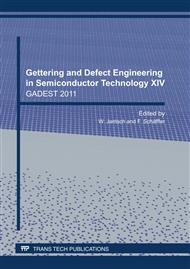p.285
p.289
p.295
p.301
p.307
p.313
p.319
p.325
p.331
TEM Characterization of near Sub-Grain Boundary Dislocations in Directionally Solidified Multicrystalline Silicon
Abstract:
A crystal is known to achieve lower energy if lattice dislocations are re-arranged in arrays forming a sub-grain boundary through a recovery process. Interaction of boundary dislocations with glide dislocations is also expected to bring about local equilibrium. In this work, dislocations localised in the vicinity of a sub-grain boundary (mis-orientation ) are studied in detail by transmission electron microscopy in order to determine their source. Contrary to the processes described above, it appears that the sub-grain boundary is the source of these dislocations, which are emitted from some locally stressed parts of the boundary. Several slip systems have been activated along the boundary resulting in high density of dislocations. It appears, further, that dislocation propagation from one or more sources is disrupted by interaction with other dislocations or other defects. The dislocations from various sources will be piled up against the obstacles of the other, resulting in the localization of the dislocations close to the sub-grain boundary
Info:
Periodical:
Pages:
307-312
Citation:
Online since:
August 2011
Authors:
Keywords:
Price:
Сopyright:
© 2011 Trans Tech Publications Ltd. All Rights Reserved
Share:
Citation:


